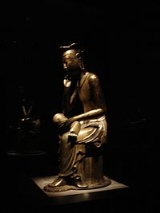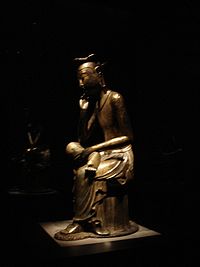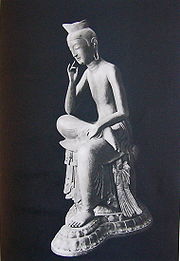
Bangasayusang
Encyclopedia
The Bangasayusang, or Geumdong Mireuk Bosal Bangasayusang (literally Gilt-Bronze Maitreya Bodhisattva Half-sitting Thinking Statue), is a gilt-bronze statue of what is believed to be the Maitreya
, the future Buddha
, in a semi-seated contemplative pose. It is commonly referred to as the Contemplative Bodhisattva or Gilt-Bronze Seated Maitreya in English. It is the National Treasure of Korea No. 83.
The Bangasayusang is widely acknowledged to be one of the finest Buddhist sculptures
ever produced and is a masterpiece of Korean art
. It is now housed at the National Museum of Korea
and is one of the most popular exhibits there.
because of drapery fold studies although some believe that this was a Baekje
piece. It is 93.5 centimeters tall or approximately 3 feet and one inch in height, and is therefore incredibly valuable because few large bronzes survived from that period. It is made of bronze, and was at one point plated in gold.
 The Bangasayusang is seated on a round pedestal and posed with its right leg of the crossed over its left knee while the figure's right hand is touching its cheek and the left hand rests on the crossed leg. This contemplative pose was a popular subject of Buddhist art and the archetype spread from India to China and Korea and then to Japan. Other common similarities of the Maitreya statues of this style is the use of drapery on the seat on which the figure sits. Chinese depictions of the drapery that the Maitreya sits on are highly stylized, stiff, and formalized. However, the artists' depiction of the drapery on the Bangasayusang is flowing and realistic which gives the statue an illusion of animation. The slender, almost lithe body of the figure suggests Baekje influences. However, the bridgeline and sharp nose of the figure suggests a Silla provenance. Although the actual provenance of the statue is still unknown, the current art historian consensus is that the statue is from a Sillan caster because of the Silla-style of the drapery depicted over the pedestal.
The Bangasayusang is seated on a round pedestal and posed with its right leg of the crossed over its left knee while the figure's right hand is touching its cheek and the left hand rests on the crossed leg. This contemplative pose was a popular subject of Buddhist art and the archetype spread from India to China and Korea and then to Japan. Other common similarities of the Maitreya statues of this style is the use of drapery on the seat on which the figure sits. Chinese depictions of the drapery that the Maitreya sits on are highly stylized, stiff, and formalized. However, the artists' depiction of the drapery on the Bangasayusang is flowing and realistic which gives the statue an illusion of animation. The slender, almost lithe body of the figure suggests Baekje influences. However, the bridgeline and sharp nose of the figure suggests a Silla provenance. Although the actual provenance of the statue is still unknown, the current art historian consensus is that the statue is from a Sillan caster because of the Silla-style of the drapery depicted over the pedestal.
The figure is perfectly proportional and the sensuality of the draping both suggests that the sculptor based this work on a real model. Other figures of the Maitreya-type are often distorted or stylized to fit the artistic tradition the sculptor was working from. The harmony between the lower half and upper half of the statue is example of the attention to detail and realistic proportionality. The figure has a tri-fold crown on its head which is very simple, unlike other works of this genre which have highly elaborate headdresses. The halo of the figure has long since been lost although a part of the halo remains attached to the figure. The Bangasayusang is also bare-chested which adds to the simplicity of the figure. The figure gives a sense of calm meditation but still conveys a sense of moving dynamism because of its posture and the artistic styling of the bronze.
 The Miroku bosatsu at the Koryu-ji
The Miroku bosatsu at the Koryu-ji
Temple of Kyoto
, which is one of the Japanese National Treasures
, is the twin of the Bangasayusang and is almost certainly of Korean origin. The Miroku is carved from red pine and may be the statue the Nihon Shoki
mentions that a King of Silla
sent to the Yamato court. The statues both share the elegant contemplative pose, highly proportional figures, realistic draperies, slim bodies, and plain tri-fold crowns.
The Bangasayusang is often compared to Auguste Rodin
's work, The Thinker
because of its contemplative pose.
National Treasure No.83, although priceless, is insured for an estimated 50 billion won
and is the most expensive national treasure of Korea.
Maitreya
Maitreya , Metteyya , or Jampa , is foretold as a future Buddha of this world in Buddhist eschatology. In some Buddhist literature, such as the Amitabha Sutra and the Lotus Sutra, he or she is referred to as Ajita Bodhisattva.Maitreya is a bodhisattva who in the Buddhist tradition is to appear on...
, the future Buddha
Buddhahood
In Buddhism, buddhahood is the state of perfect enlightenment attained by a buddha .In Buddhism, the term buddha usually refers to one who has become enlightened...
, in a semi-seated contemplative pose. It is commonly referred to as the Contemplative Bodhisattva or Gilt-Bronze Seated Maitreya in English. It is the National Treasure of Korea No. 83.
The Bangasayusang is widely acknowledged to be one of the finest Buddhist sculptures
Korean Buddhist sculpture
Korean Buddhist sculpture is one of the major areas of Korean art. Some of the finest and most technically accomplished Buddhist sculpture in East Asia and World were produced in Korea....
ever produced and is a masterpiece of Korean art
Korean art
Korean art is art originating or practiced in Korea or by Korean artists, from ancient times to today. Korea is noted for its artistic traditions in pottery, music, calligraphy, and other genres, often marked by the use of bold color, natural forms, and surface decoration.-Introduction:The earliest...
. It is now housed at the National Museum of Korea
National Museum of Korea
The National Museum of Korea is the flagship museum of Korean history and art in South Korea and is the cultural organization that represents Korea...
and is one of the most popular exhibits there.
Origins
The statue is believed to have been made in the early 7th century. Recent scholarship consensus indicates that the statue is probably from SillaSilla
Silla was one of the Three Kingdoms of Korea, and one of the longest sustained dynasties in...
because of drapery fold studies although some believe that this was a Baekje
Baekje
Baekje or Paekche was a kingdom located in southwest Korea. It was one of the Three Kingdoms of Korea, together with Goguryeo and Silla....
piece. It is 93.5 centimeters tall or approximately 3 feet and one inch in height, and is therefore incredibly valuable because few large bronzes survived from that period. It is made of bronze, and was at one point plated in gold.
Description

The figure is perfectly proportional and the sensuality of the draping both suggests that the sculptor based this work on a real model. Other figures of the Maitreya-type are often distorted or stylized to fit the artistic tradition the sculptor was working from. The harmony between the lower half and upper half of the statue is example of the attention to detail and realistic proportionality. The figure has a tri-fold crown on its head which is very simple, unlike other works of this genre which have highly elaborate headdresses. The halo of the figure has long since been lost although a part of the halo remains attached to the figure. The Bangasayusang is also bare-chested which adds to the simplicity of the figure. The figure gives a sense of calm meditation but still conveys a sense of moving dynamism because of its posture and the artistic styling of the bronze.
Similar works

Koryu-ji
is a Shingon temple in Uzumasa, Ukyō Ward, Kyoto, Japan. The temple is also known by the names and , and was formerly known as , and .Kōryū-ji is said to be the oldest temple in Kyoto, having been constructed in 603 by Hata no Kawakatsu upon receiving a Buddhist statue from Prince Shōtoku...
Temple of Kyoto
Kyoto
is a city in the central part of the island of Honshū, Japan. It has a population close to 1.5 million. Formerly the imperial capital of Japan, it is now the capital of Kyoto Prefecture, as well as a major part of the Osaka-Kobe-Kyoto metropolitan area.-History:...
, which is one of the Japanese National Treasures
National treasures of Japan
National Treasures are the most precious of Japan's Tangible Cultural Properties, as determined and designated by the Agency for Cultural Affairs...
, is the twin of the Bangasayusang and is almost certainly of Korean origin. The Miroku is carved from red pine and may be the statue the Nihon Shoki
Nihon Shoki
The , sometimes translated as The Chronicles of Japan, is the second oldest book of classical Japanese history. It is more elaborate and detailed than the Kojiki, the oldest, and has proven to be an important tool for historians and archaeologists as it includes the most complete extant historical...
mentions that a King of Silla
Silla
Silla was one of the Three Kingdoms of Korea, and one of the longest sustained dynasties in...
sent to the Yamato court. The statues both share the elegant contemplative pose, highly proportional figures, realistic draperies, slim bodies, and plain tri-fold crowns.
The Bangasayusang is often compared to Auguste Rodin
Auguste Rodin
François-Auguste-René Rodin , known as Auguste Rodin , was a French sculptor. Although Rodin is generally considered the progenitor of modern sculpture, he did not set out to rebel against the past...
's work, The Thinker
The Thinker
The Thinker is a bronze and marble sculpture by Auguste Rodin, whose first cast, of 1902, is now in the Musée Rodin in Paris; there are some twenty other original castings as well as various other versions, studies, and posthumous castings. It depicts a man in sober meditation battling with a...
because of its contemplative pose.
National Treasure No.83, although priceless, is insured for an estimated 50 billion won
South Korean won
The won is the currency of South Korea. A single won is divided into 100 jeon, the monetary subunit. The jeon is no longer used for everyday transactions, and appears only in foreign exchange rates...
and is the most expensive national treasure of Korea.

